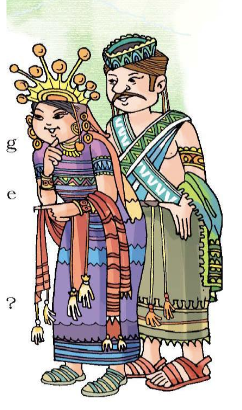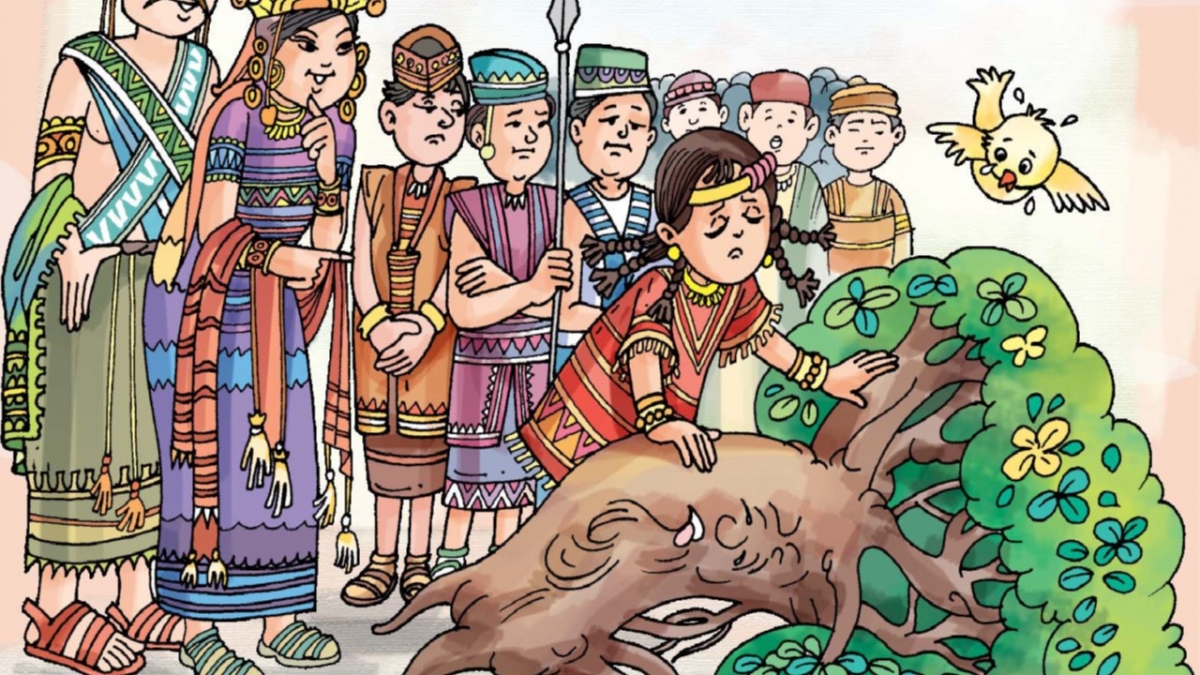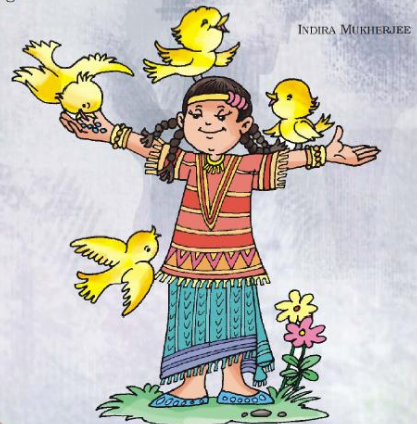Pre-Reading Process: Slot 1
- Since this textbook lesson is in the form of a good narrative, the teacher can use it for the narration itself.
- You must read such narratives in a slow pace, with proper voice modulations and gestures.
NARRATION
Today, I am going to talk to you about a Manipuri story.
Do you know where Manipur is in the map of India?
In Manipuri language, a king is called ningthou while a queen is called leima.
Who are the ningthou and leima in the following picture?

INTERACTION
- How do we refer to a king and queen in Tamil?
- Do you know the names of a few famous kings and queens you studied before?
- Do you remember any stories about them?
- Whom would you call a good king? Whom would you call a bad king? Give reasons.
The purpose of these interactive questions is to familiarise the students with the theme concerning the good qualities of a king.
NARRATION
Okay. Let me tell you a story about choosing a ningthou. Listen carefully.
Long, long ago, in the land of Kangleipak in Manipur. ... A daughter was born to the ningthou after twelve years. They named her Sanatombi. She was a lovely child – soft and beautiful inside. Everyone loved her.
- Read the narrative given in the text from ‘Long, long ago’ till ‘she was loved by one and all’ (page 176) in a slow pace, with proper voice modulations and gestures.
INTERACTION
- What is a king called in Manipuri? What about a queen?
- Where does this story take place?
- In Manipuri, what word is used for ‘people’?
- How many children did the ningthou and leima of Kangleipak have?
- Who was Sanatombi? What do you know about her?
- Do you think the people of Kangleipak were the only ones who loved their king? Why do you think so?
- A picture is given on page 179 of your text. Can you identify the six characters in it?
Elicit the following responses from the students and write them on the blackboard (BB).
- A king is called ningthou, while a queen is called leima.
- The story takes place in the land of Kangleipak in Manipur.
- Meeyam means ‘people’ in Manipuri.
- The ningthou and leima in the story had four children: three sons and a daughter.
- Sanatombi was the daughter of the ningthou and leima of Kangleipak. She was a lovely child– soft and beautiful inside.
- The people of Kangleipak were not the only ones who loved their king and queen. The birds,animals, and trees of the land loved them as well.
Call a few students near the BB, and ask them to read what is written on it.
NARRATION
The years went by, and the ningthou’s children grew up well. ... Whoever reached the Khongnang, the banyan tree, first would be declared Tunggi Ningthou.
INTERACTION
- What did the ningthou discuss with his ministers?
- What is Tunggi Ningthou?
- Why were the ministers shocked?
- What type of a king did the ningthou want to select?
- What kind of a contest was held to select the king?
- What name is used to refer to the banyan tree? Can you locate the word in the textbook?
- Do you like the decision made by the ningthou? Give reasons.
- Who do you think will win the contest? Why do you think so?
- If you were one of the ministers, what other contest would you have suggested for the selection of the future king?
Elicit the following responses from the students, and write them on the BB.
- The ningthou discussed the selection of Tunggi Ningthou with his ministers.
- Tunggi Ningthou is the future king.
- The ministers were shocked because as per tradition, the ningthou’s eldest son would become the new king.
- Ningthou wanted to select a king who was most worthy of becoming one.
- The contest decided for the future king’s selection was a horse race.
- Khongnang was the name of the banyan tree.
Call three to four students to the front of the class, and ask them to read the subtext written on the BB.
NARRATION
But then, a strange thing happened. Can you guess what it was?
Sanajaoba, Sanayaima, and Sanatomaba, all three of the ningthou’s sons, finished the race together.
...
Shouts of ‘Thouro! Thouro! Phajei! Phajei!’ filled the mountains.
INTERACTION
- What happened during the horse racing contest? Do you think the three sons were experts at horse racing?
- What did the people of Kangleipak shout on watching the horse race?
- What did Sanjaoba do to prove his skills the second time around?
- What did Sanayaima do to prove his skills?
- What did Sanatomba do in order to prove his skills?
- Whose performance did you like the most?
- The people shouted different words to congratulate the princes. Can you list them and explain their meanings?
- Who pierced the Khongnang tree?
- Who uprooted the banyan tree?
- Do you think the tree felt pain? What happened to it?
- Whom do you think the ningthou would choose as Tunggi Ningthou?
Elicit the following responses from the students, and write them on the BB.
- The horse racing contest ended in a draw. The three sons were experts in horse racing.
- The people shouted ‘Thouro’ and ‘Phajei’, which mean ‘bravo’ and ‘wonderful’, respectively.
- Sanjaoba pierced the Khongnang tree and jumped through it.
- Sanayaima jumped over the tree.
- Sanatomba uprooted the tree.
Reading Process: Slot 1
Ask the students to read the text, starting from ‘Long, long ago, in the land of Kangleipak in Manipur’ to ‘Shouts of ‘Thouro! Phajei!’ filled the mountains’.
1. Individual Reading
- Ask the students to read the text individually.
- Give them the following instructions before they start reading:
- Put a question mark against the lines that you cannot understand.
- Underline the lines you could read and understand.
- Go round the class and monitor the students’ reading process.
- Invite their attention to the sentences on the BB and the expressions noted on it.
2. Collaborative Reading
Divide the students into small groups, and give them the following instructions:
- Each member should take turns and present the others with an idea from the text. o Read the sentence in the text that contains the discussed idea.
- Let the others in your group locate the sentence and read it.
- Share with the other members what you could read and understand.
- Now tell your group members the words and/or sentences you could not understand. o Guess the underlying idea collectively.
- If you still cannot understand the meaning, you can ask your teacher.
3. Reading Aloud
- Read the text on page 176 slowly and with proper voice modulations.
- Ask the students to sit in groups.
- Ask them to take turns and read aloud a sentence each from the text.
Comprehension Questions
The interaction questions we asked earlier can be asked once again, to check the students’ comprehension. A few additional questions are given below:
- Can you locate in the text the name of the land in which the story takes place?
- Why did the people of Kangleipak love their king and queen?
- Why did the ningthou want?
- ‘Our meeyam should be happy’: whose words are these?
- Some words/expressions used in Manipuri have been mentioned in the story. Can you list them and write their meanings in both English and Tamil?
Post-Reading Process: Writing
Ask the students to sit in groups and write an answer on the following question: In your own words, describe the horse racing contest that took place between the princes.
Before the students start writing, you can hold a brainstorming session with them using the following sub-questions:
- What contest was held by the king?
- Who were the people involved in it?
- Where did the contest take place?
- How did each prince perform?
- Who won the contest?
- How did the people react?
Ask the students to write their descriptions on a chart.
Editing process
- Group Presentation: Ask the groups to present their version of the story.
- Teacher’s version: You may present your version of it as well.
Model for the Teacher’s Version
A horse racing contest for the selection of the future king
In the land of Kangleipak in Manipur, a horse racing contest was held for the selection of the future king. In the contest, the prince who reached the banyan tree Khongnang first would be declared the winner. The three princes – Sanajaoba, Sanayaima, and Sanatomba – participated in the contest. To everyone’s surprise, all three of them finished the race together. They all reached the finish line at the same time! The spectators shouted, ‘Expert horsemen!’ However, no winner could be decided from this contest. Thus, the king had to conduct another contest for the princes.
- Edit one group’s work following the process given below:
A. Check the theme (sequencing of the ideas).
B. Check the grammar of the sentences.
- Whether any words are missing;
- If any sentence has a wrong word order;
- Whether any sentence has excess number of words;
- If any changes are required regarding the word forms used (for instance, tense, plurals, etc.).
C. Review the following writing conventions: capitalisation and punctuation.
- Ask the students to rewrite their group work written in their notebooks based on the teacher’s feedback.
Pre-Reading Process: Slot 2
NARRATION
Sanatomba carried the Khongnang tree to the ningthou and leima and laid it at their feet. The people of Kangleipak were so excited. They praised Sanatomba. But, the ningthou and leima took more time to declare the winner.
‘Why is the king take more time to choose the winner?’ the people asked each other. Do you know the reason? Let’s look at the picture.

PICTURE-BASED INTERACTION
- Who is the small girl touching the tree?
- Is Sanatombi happy? Why do you think so?
- What made Sanatombi sad?
- What happened to the banyan tree?
- Why are the birds crying?
- What are the ningthou and leima doing?
NARRATION
Read the text from ‘The people grew restless. Sanatombi felt the pain of others. She could feel the pain of the people, animals, birds, and trees’ with proper voice modulation and at a slow pace.
INTERACTION
- Who looked sad and lonely?
- What did the birds do when the tree was cut down?
- What did Sanatombi whisper to the banyan tree?
- Whom did the ningthou declare as the future leima?
- Why did the king choose Sanatombi as the future leima?
- Do you think the three princes would be happy with the king’s decision? Why do you think so?
Elicit the students’ responses, and write them down on the BB.
- Sanatombi looked sad and lonely.
- The birds flapped worriedly. They searched for their homes in the fallen tree.
- Sanatombi whispered to the tree that it is dead by the spear.
- The ningthou declared Sanatombi as the future leima.
- The king chose Sanatombi because she felt the pain of others. She could feel the pain of not only the people but also the animals, birds, and trees.
PICTURE-BASED INTERACTION

- Who is the little girl shown in the picture above?
- What are the birds doing? Are they afraid of Sanatombi? How do you know?
- Do you think Sanatombi is the right person to be the future queen? Give reasons for your answer.
NARRATION
- Read the text from ‘I declare Sanatombi as the future Leima of Kangleipak. A leima is one who doesn’t hurt anybody in the kingdom.’
INTERACTION
- What did the birds circling Sanatombi do?
- What is there on Sanatombi’s palm?
- Who is a true leima?
- If you were Sanatombi, what would you tell the people of Kangleipak?
Elicit the following responses from the students, and write them down on the BB.
- The birds flew around her, sat on her head and shoulders, and pecked at the grains.
- A few grains are there on Sanatombi’s palm.
- A true leima is one who does not hurt anybody in the kingdom.
Reading Process
Repeat the same process you followed for the first part of the text.
- Individual Reading
- Collaborative Reading
- Reading Aloud
Comprehension Questions
All the interaction questions that were asked before can be asked again to check the students’ comprehension. A few additional questions are given below:
- How old was Sanatombi? Can you locate the answer for this question from the text?
- What did Sanatombi whisper to the tree? Locate the answer in the text.
Post-Reading Process: Writing and Editing
- Ask the students to individually describe the picture given on page 179.
- Ask them to present their individual versions.
- Take one of them and edit it.
- Display the teacher’s version.
- Ask the students to rewrite their version based on the teacher’s feedback.
DRAMATISATION OF THE ENTIRE LESSON
Process of Generating the Drama
- Ask the students to identify the main incidents/actions in the story and subsequently list them in chronological order.
Example
A baby girl was born after twelve years.
The ningthou called all his ministers.
All three princes finished the race together.
The people shouted.
Note: Help the students understand how statements such as ‘There lived a king and queen’, ‘They had three sons,’ and ‘She was a lovely child’ are not incidents but descriptions.
- Ask the students to identify the dialogues in the story and write them down. Moreover, match them with the corresponding incident.
Example
‘Everybody in Kangleipak should live in peace.’
‘It is now time to decide the Tunggi Ningthou.’
‘But, O Ningthou, what is there to decide?’ ‘Look at them.’
Note: Tell the students how the dialogues will be written in the text with quotation marks.
Write the dialogues for each action taking place in the story. Do not use the textbook dialogues themselves for the drama.
1. Ask the students to identify the characters uttering a dialogue and whom they are speaking to.
These characters are performing certain actions and talking. Go through the textbook and pictures to find out what are they doing.
2. Ask the students to write down where these incidents take place (place of action).
Examples
The horse race contest: near the banyan tree, outside the palace;
The meeting between the king and his ministers: inside the palace.
3. Let the groups plan the drama by allotting a character to each group member.
4. Let them practice the dialogues.
5. Let them present/enact their drama.
6. Elicit reflections from the students regarding their performance.
7. Give your feedback using the following questions:
- Did you cover all the events?
- Are the dialogues sufficient?
- Do you want to add more dialogues?
- Do you want to change any dialogues?
- Could the entire class hear your dialogues?
- Did you deliver the dialogues with emotions such as joy, sadness, anger, and so on?
Term: Term 3
Comments
Thank you